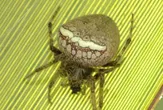Harmful Effects of Tuft-legged orbweaver
A species of Mangora
Health risks from tuft-legged orbweaver to humans are minimal, as bites are rare and occur defensively. When bites happen, they cause mild symptoms due to insignificant venom potency. Transmission of health risks is primarily through direct contact. These issues are not life-threatening and typically do not require medical treatment.
Is the Tuft-legged orbweaver poisonous?
Does the Tuft-legged orbweaver bite humans or animals?
Harmful Facts About Tuft-legged orbweaver









AI entomologist in your pocket
Scan QR code to download

